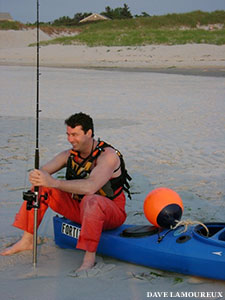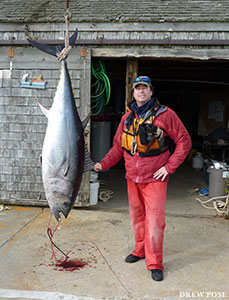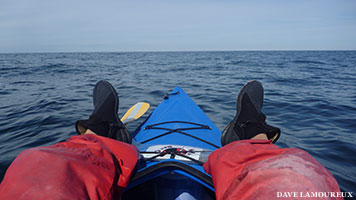On a September day three years ago, Dave Lamoureux decided to take the 12-foot Heritage kayak off the wall in the garage of his family’s three- bedroom summer house and drop it into Lewis Bay, a nook on the southern side of Cape Cod. He brought a fishing rod along, too.
To this point in his life, Lamoureux had tried about everything in the water. His father used to own some small boats and lobster traps, and Lamoureux and his older brother spent summers sailing, diving, trapping, water-skiing, snorkeling, scalloping, oystering, crabbing, and, above all, fishing. When he was younger, he devised his own trident spear to hunt for eels in Parker’s River.
Even as he moved away from Massachusetts, pursuing a financial career in California and then Chicago, Lamoureux always made time for fishing. Vacations usually took him to sport-fishing havens like Brazil or Costa Rica. And on some long weekends, he would return to Cape Cod.
During one such weekend, Lamoureux thought he might try something. He had kayaked only once before his in life -- a forgettable trip in the waters outside Seattle 20 years earlier -- but he looked at the recreational craft on the garage wall and imagined a mobile fighting chair, one that could actually move along with the fish. He dreamed it might give him a shot to one day land perhaps the most prized fish in the sea: the Atlantic bluefin tuna.

In the years since, Lamoureux has emerged as something like a celebrity in the bait shops and chowder dives dotting the Cape Cod coast, and beyond. He earned acclaim in November 2009 when he made national headlines by catching a world-record, 5-foot-6, 157-pound bluefin tuna unassisted in his kayak, several miles off Race Point at the crooked tip of the Cape. He has distinguished himself as the only fisherman of his kind, slipping through the grey slate sea miles out in the Atlantic, silent as the mist, alone and entirely vulnerable to the harsh New England oceanic extremes.
His activity is not universally liked -- commercial fishermen and fishing blogs have been critical of what they perceive as unnecessary risk -- but few discredit the endurance and perseverance that goes into it.
“It is the Everest, I think,” Lamoureux says. “I’ve talked to the guys in Florida who say I need to fish tarpon. But what the heck could top this?”
On weekdays, Lamoureux is a trader and portfolio manager for a private investment firm in Chicago. He is tall and clean-shaven, 44 years old, about 6-foot-1 and 220 pounds, with short wavy brown hair and that distinctive eastern Massachusetts accent that may be his only superficial connection to the commercial fishermen he shares the deep waters with. Sitting in a hotel lobby here in Cambridge, around the block from where he rents an apartment, Lamoureux wears a blue dress shirt and tie and sips a latte.
He then dives into an explanation of a one-handed harpoon he has designed.
“He always analyzed the problem and figured out the best way to achieve his goal,” says his brother, Paul, the program director at the Thompson Island Outward Bound in Boston. “But his goal was always pretty extreme.”
The perils of fishing off the coast of Cape Cod -- notorious for its Great White sharks, and home to frequent fast-moving storms, treacherous tides, whales and seals -- are accounted for with preparation and planning. Lamoureux has evolved into an expert meteorologist and a skilled reader of tidal trends, wind speeds, wave heights.
But as the first streaks of sunlight appear over the eastern horizon, and Lamoureux dips the bow of his Featherlite kayak into the dark Atlantic waters, that planning could be annulled instantaneously, leaving just him and the wicked sea.
The Atlantic bluefin tuna, which averages more than six feet in length and 550 pounds, is considered the largest, fastest, feistiest and most powerful big-game fish in the seas. It can travel at speeds up to 50 mph, often swims more than 100 miles per day and its tail moves quicker than the human eye, similar to a propeller. Its metallic skin makes it tough for hooks to penetrate.
Its dark and fatty meat also makes bluefin coveted as a sushi fish, hunted intensely by the Japanese, who account for more than 80 percent of a market that many environmentalists believe is dangerously overfished.
For years, bluefin have centered in the concerns surrounding global fishing -- "60 Minutes" did a piece two years ago on Tokyo’s biggest fish market, which runs at a revenue of more than $4 billion annually.

More recently, a serious debate has emerged in the United States about whether bluefin should be wholly protected. Not surprisingly, the petition for it to be listed as endangered -- pushed by the Arizona-based Center for Biological Diversity -- has caused an outcry from commercial fishermen, who point toward the Mediterranean and North African fisheries as the biggest culprits in depleting the Atlantic bluefin stock. Already, fishing for bluefin in the Gulf of Mexico (traditional spawning ground) is prohibited and the numbers of tuna allowed per boat have been curtailed.
In January, the National Oceanic and Atmospheric Administration (N.O.A.A.) held a series of town-hall meetings around New England to allow fishermen to vent their concerns. More than 100 showed up at the first one in Boston.
Dave Lamoureux did not. Because he is neither a commercial fisherman, nor does he take any sponsorship, Lamoureux says he sees both sides of the argument. Environmentalists want to protect a species that has declined by an estimated 80 percent in stock numbers since 1975. Fishermen want to maintain their livelihood and are skeptical of some of the calculating methods for counting tuna.
“It’s easy to find a way to count elephants in Africa,” Lamoureux says. “How the heck do you spot millions of pelagic fish that swim 40 miles per hour?”
Lamoureux did need to go down a laundry list of regulations to be able to fish for bluefin -- even recreationally. He raised a few eyebrows when he explained to officials what he planned on doing.
He met with a management specialist from the National Marine Fisheries Service (N.M.F.S.), Brad McHale, who went line-for-line through a legal document from the Code of Federal Regulations concerning tuna fishing.
“He made sure he had his I’s dotted and T’s crossed as far as how to fish in this manner so it was completely legal,” McHale says.
Lamoureux had to register for a Highly Migratory Species angling category permit with the N.M.F.S. and acquire a state permit through the Massachusetts Registry of Motor Vehicles.
When he registered with the state of Massachusetts, a space on the form momentarily stumped him. The form asked for the name of his vessel. It being a kayak, Lamoureux had not considered one before.
He paused for a few moments before he filled in “Fortitude.”
For every one of Dave Lamoureux’s fishing trips, he parks his station wagon in the lot at Race Point at the outer crook of the tip of the Cape around dawn, gathers more than 150 pounds of equipment, and drags the gear across 400 yards of dunes toward the lip where the surf meets the sand.
Lamoureux uses the same kayak he picked up off the wall of his father’s garage -- a 12-foot Heritage Featherlight recreational craft intended for use in ponds and rivers. He decided against using a sea kayak because of its lack of stability when fighting a fish; a fishing kayak lacked seaworthiness in rough seas. And despite offers from potential sponsors to upgrade, Lamoureux has stayed with Fortitude.
Because Lamoureux does everything on his own -- including dragging his fish across an empty beach and into the back of his station wagon -- nothing on fishing day comes lightly.
“I didn’t just one day go five miles off shore,” Lamoureux says.
But Lamoureux believes he is also very safe. Along with him in his kayak is a GPS, VHF radio, cell phone, compass, two fog horns, a strobe, dive fins (for self-rescue), a harpoon, extra line, two tuna buoys and the 50-foot cable line they’re attached to, a bag of six ballyhoo, three army knives, two quarts of Gatorade, a lifejacket, a first aid kit, five flares, a pack of 5-Hour Energy drinks, a flashlight, hat, sunglasses, and sun block. He estimates he goes through six waterlogged cell phones every summer.

His rods are seven feet long, custom-built, and faced backwards, anchored to the kayak as he paddles. He invented and patented a better way to stabilize the reels. The rods are trolled behind the kayak, and each rod has one specially rigged ballyhoo, a baitfish with a beak like a tiny swordfish.
Lamoureux never stops paddling, because the ballyhoo need to keep moving, and the tuna swim in schools toward the trolling baitfish, and the moment of impact can hit like a jackknifed car. And then Lamoureux goes for his ride.
The Nantucket Sleigh Ride was coined by Herman Melville as a fantastical description for how skippers would ride out whales they had harpooned off the coast of Nantucket, dragging the whale boats behind them like aluminum cans roped to a car.
Lamoureux had fantasized about the experience. Before he began fishing for tuna, he went out kayaking with his brother and mentioned it offhandedly.
“I could see his mind working,” Paul says. “He told me he wanted to go for a Nantucket Sleigh Ride. He was already thinking about it.”
When it first happened, Lamoureux said he was not expecting it. His first big catch, though, quickly ran out all the line. The tuna started pulling him behind it. He shot across the water for 15 minutes.
Now about every tuna Lamoureux hooks takes him on a ride -- it is his only means of slowing down a fish that usually heads directly out to sea when panicked. The smaller tuna Lamoureux is able to wear down and slowly reel in; the larger ones eventually forget he is still hanging on.
That’s what happened two summers ago, in July, when Lamoureux hooked what nearby commercial fishermen (using sonar) estimated as a tuna weighing 800 pounds (Lamoureux says anything between 400 and 800 pounds feels the same). It carried the Fortitude around for hours, never tiring, until Lamoureux had to cut the line, setting the fish free to fight against weightier opponents, fishermen with boats and rigs, loaded lines
and muscled mechanisms.
Lamoureux is working on devising a drag system that would enable him to add resistance once a fish is hooked. The notion of a kayaker taking a tuna for a ride bothers some other fishermen, though, and after news of Lamoureux’s record catch some on blogs sounded off.
“Great reason to kill fish. Can you say EGO?” one user on a message board wrote. “He is probably a disaster waiting to happen,” added another.
Other fishermen caution that many bluefin are too big for Lamoureux to realistically expect to reel in, and his eagerness to sleigh ride is not sound judgment but a lot of folly -- too risky, too dangerous, and too extreme to be considered anything but lunacy.
“I don’t have anything personally against him,” says one local charter boat captain who asked to remain anonymous. “It’s just not safe, and it’s not good to target bluefin tuna recreationally in a kayak like that.”
Lamoureux has heard all of the detractors and shrugs. His response is that he has been fishing on the Cape since he was three -- when his father took him out for sun fishing -- and he feels he has calculated all the risk.
“He’s a better meteorologist than some of those TV guys,” says Tim Donovan, a deputy agent for the N.O.A.A. Office of Law Enforcement and a high school friend. “He’s really taken a hobby and turned it into a vocation.”
Most of his gear he engineered specifically for himself. He works out and conditions his upper body and torso to handle 15 miles of paddling.
Lamoureux has also spoken at fishing expos and trade shows to try educating people about what he does, and how it should not be readily repeated.
“I wanted to make sure I was publically making clear the risk,” he says. “There are people that like you and people that hate you. Some don’t know me and don’t know what I did to get out there. They all think now there are going to be 300 idiots out there drowning because I am out there.
“I’m not the 20-year-old who just wants to get on YouTube.”
When he was a freshman in high school in Melrose, Massachusetts, Lamoureux was injured playing hockey and had to quit. Too many checks to the midsection left him vulnerable to potential damage to his kidneys.
Doctors forbade him from playing any contact sports, so Lamoureux found other means of feeding his love for athletic activity. He took up skiing and soon frequented some of the steepest slopes in New England. In the summers, he would fish.
Lamoureux always seemed to drift naturally toward hobbies involving some amount of risk. It is not an attribute he can easily explain. Extreme athletes often cannot. It is not that he is fearless or pumped full of testosterone or stoked with adrenaline. Lamoureux mostly believes he can outthink most of the inherent danger.
The list of those dangers stretches from sharks to hypothermia, in a fearsome plot of ocean once home to the Perfect Storm, where a man in a kayak can simply vanish in the froth as easily as a blizzard can erase climbers on Everest. Lamoureux might refute that comparison and rattle off a statistic about how many hikers do die on Everest every year. There are, of course, no statistics on the deaths of kayak fisherman chasing tuna. Such intrepidity puts a twinkle in Lamoureux’s eye, but he also believes he knows enough about fishing to feel safe out there.

“I’m at home on the ocean,” he says. “I understand the ocean.”
After attending Babson College and graduate school at DePaul University, he fell into trading, joining the other risk-lovers on the floor of the Chicago Futures exchanges. It had its large share of excitement -- a requisite, no doubt -- and also the financial freedom to break away from the office on occasion, test the limits of his personal athletic extremes. While in Chicago, he would race sailboats across Lake Michigan with the Chicago Yacht Club. In California, he climbed El Capitan at Yosemite and Lover’s Leap at Tahoe. He lived for a year in Jackson Hole, Wyoming.
But few things could top Lamoureux’s tender relationship with the ocean. He began spending more vacation time in the three-bedroom Cape house of his youth.
When he took the kayak off the garage wall he had only vague notions of what he could one day accomplish with it, and already he has surpassed them.
“For where I am, it is the be-all end-all,” Lamoureux says of fishing bluefin. “It will reach that point when the reward gets less.
“But I can’t wait for the upcoming season.”
One day last summer, Lamoureux caught an 80-pound tuna and fastened it behind his kayak. And in the waves, the fish thrashed, and bled, and the route in to land was long and rough. A shark caught the trail -- Lamoureux found this out only afterwards, when a National Park official informed him that a large Great White had been creeping behind him for miles.
That’s a fish tale, of course. Like how the old man Santiago might have told it: Exaggeration acceptable, with hand motions and wide eyes, that salty charm.
There are tales that belong only to Lamoureux, the fishing financier, so he may sprinkle in some embellishment. Add some romance and some intrigue to illuminate that eternal fight, hunting for giant fish in the sea.
